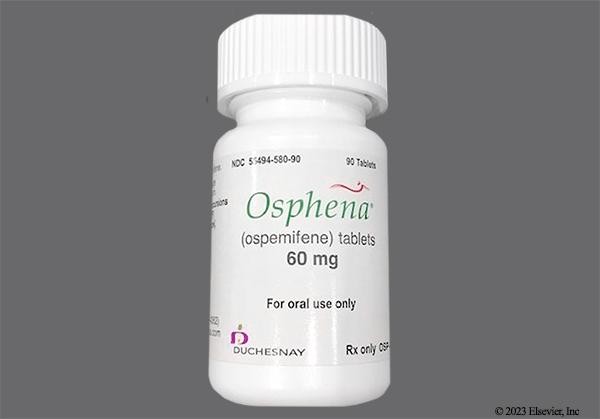
Contents
ospemifene
Ospemifene is a medication used to treat moderate to severe vaginal dryness and painful sexual intercourse (dyspareunia) caused by menopause. Menopause reduces estrogen production, resulting in degeneration (atrophy) and dryness of the vulvar and vaginal tissue, as well as pain during and after intercourse. Ospemifene significantly reverses vulvar and vaginal atrophy (VVA) associated with menopause and improves symptoms after 12 weeks of therapy.
Ospemifene is a selective estrogen receptor modulator (SERM) that activates estrogen pathways in certain tissues and blocks them in others. It has estrogen-like effects on the endometrium, the inner lining of the uterus. In women with VVA, ospemifene has estrogen-like effects in the vagina, reducing dryness and pain during intercourse. It selectively binds to estrogen receptors and modulates estrogenic pathways.
Warnings
- Ospemifene should not be used in women with the following conditions: Hypersensitivity to any of the components of ospemifene, undiagnosed abnormal genital bleeding, active or history of deep vein thrombosis (DVT) or pulmonary embolism, active arterial thromboembolic disease like stroke or heart attack (myocardial infarction), known or suspected estrogen-dependent tumors (neoplasia), or women who are or may become pregnant.
- Prescribe ospemifene for the shortest duration possible according to treatment goals and risks.
- Manage risk factors for cardiovascular diseases like hypertension, diabetes mellitus, obesity, hypercholesterolemia, systemic lupus erythematosus, history of venous thromboembolism, and tobacco use.
- Do not use ospemifene in women with active cardiovascular disorders.
- Discontinue ospemifene immediately if venous thromboembolism, hemorrhagic stroke, or thromboembolic stroke occurs or is suspected.
- Discontinue at least 4 to 6 weeks before surgery with an increased risk of thromboembolism or during periods of prolonged immobilization if possible.
Side Effects
Common side effects of ospemifene include:
- Hot flush
- Vaginal discharge
- Muscle spasm
- Headache
- Excessive sweating (hyperhidrosis)
- Night sweats
- Vaginal hemorrhage
Less common side effects of ospemifene include abnormal, benign, or malignant new tissue growth (neoplasm) such as cysts, polyps, endometrial tissue overgrowth (hyperplasia), and endometrial cancer. It can also cause generalized rash, red rash (erythematous rash), hives (urticaria), itching (pruritus), and swelling of tissue beneath the skin and mucous tissue (angioedema).
Contact your doctor immediately if you experience any of the following symptoms or serious side effects:
- Serious heart symptoms like fast or pounding heartbeats, fluttering in your chest, shortness of breath, and sudden dizziness
- Severe headache, confusion, slurred speech, severe weakness, vomiting, loss of coordination, feeling unsteady
- Severe nervous system reaction with very stiff muscles, high fever, sweating, confusion, fast or uneven heartbeats, tremors, and feeling like you might pass out
- Serious eye symptoms like blurred vision, tunnel vision, eye pain or swelling, or seeing halos around lights
This is not a complete list of all side effects or adverse reactions that may occur. Contact your doctor for medical advice about serious side effects or adverse reactions. You can also report side effects or health problems to the FDA at 1-800-FDA-1088.
Dosages
Tablet
Adult:
Dyspareunia
- Estrogen agonist/antagonist for treatment of moderate-to-severe dyspareunia due to menopause
- 60 mg orally every day with food
- Use for the shortest duration according to treatment goals and risks
- Periodically reevaluate to determine if treatment is still necessary
Vaginal Dryness
- Treatment of moderate-to-severe vaginal dryness due to menopause
- 60 mg orally once daily with food
- Use for the shortest duration according to treatment goals and risks
- Periodically reevaluate to determine if treatment is still necessary
Dosage Modifications
- No dosage adjustment is required for renal impairment or mild-to-moderate hepatic impairment.
- Severe hepatic impairment: Not studied; do not use
Pediatric:
- Safety and efficacy not established
Overdose
There is no information on ospemifene overdose. Overdose may increase side effects’ intensity. Chronic use may increase the risk for endometrial cancer and blood clot blockage (thromboembolism) in blood vessels. Ospemifene toxicity may be treated by discontinuing the drug and providing symptomatic care.
Drug Interactions
Inform your doctor of all medications you are currently taking to check for possible drug interactions. Always consult your doctor before starting or discontinuing any medication.
- Severe interactions with ospemifene include bazedoxifene/conjugated estrogens, clomiphene, conjugated estrogens, dienogest/estradiol valerate, estradiol, estrogens conjugated synthetic, estrogens esterified, estropipate, and raloxifene.
- Other interactions include abametapir, apalutamide, ceritinib, fexinidazole, idelalisib, ivosidenib, lonafarnib, tucatinib, and voxelotor.
- Further interactions include acetazolamide, anastrozole, chloramphenicol, cimetidine, cyclophosphamide, nitazoxanide, and omeprazole.
The list above does not include all possible interactions or adverse effects. For more information on drug interactions, visit the RxList Drug Interaction Checker. Inform your doctor, pharmacist, or healthcare provider of all prescription and over-the-counter medications you use, including the dosage for each, and keep a list of the information. Consult your doctor or healthcare provider if you have any questions about the medication.
By clicking "Submit," I agree to the MedicineNet Terms and Conditions and Privacy Policy. I also agree to receive emails from MedicineNet and I understand that I may opt out of MedicineNet subscriptions at any time.
Pregnancy and Breastfeeding
- Ospemifene can cause fetal harm and should not be used by pregnant women.
- No information is available on the presence of ospemifene in breastmilk or its effects on milk production or the breastfed infant. However, the drug is excreted in animal milk. Nursing mothers should avoid breastfeeding if they take ospemifene.
Other Important Information
- Take ospemifene exactly as prescribed.
- Discontinue ospemifene and notify your physician if you experience hypersensitivity reactions such as rash, hives, itching, or swelling (angioedema).
- Ospemifene may cause or increase the incidence of hot flashes in some women.
- Report any abnormal vaginal bleeding to your physician immediately.
- Store ospemifene safely out of reach of children.
- In case of overdose, contact your physician or Poison Control.
From
Women’s Health Resources
- Checkups You Shouldn’t Miss
- Embracing the Changes of Menopause
- Treating Hot Flashes: What Helps?
Featured Centers
- What Are the Best PsA Treatments for You?
- Understanding Biologics
- 10 Things People With Depression Wish You Knew
Summary
Ospemifene is a medication used to treat moderate to severe vaginal dryness and painful sexual intercourse (dyspareunia) caused by menopause. Common side effects of ospemifene include hot flashes, vaginal discharge, muscle spasm, headache, excessive sweating (hyperhidrosis), night sweats, and vaginal hemorrhage. Ospemifene can cause fetal harm and should not be used by pregnant women. Nursing mothers should avoid breastfeeding if they take ospemifene.


